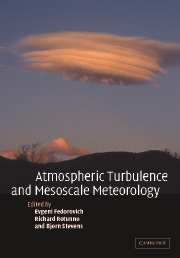Book contents
- Frontmatter
- Contents
- Preface
- Douglas K. Lilly: a biography
- Part I Atmospheric turbulence
- 1 Changing the face of small-scale meteorology
- 2 Phenomenological hunts in two-dimensional and stably stratified turbulence
- 3 Energy dissipation in large-eddy simulation: dependence on flow structure and effects of eigenvector alignments
- 4 Dreams of a stratocumulus sleeper
- 5 Large-eddy simulations of cloud-topped mixed layers
- Part II Mesoscale meteorology
- Appendix A Douglas K. Lilly: positions, awards, and students
- Appendix B List of publications by Douglas K. Lilly
- Index
- Plate section
2 - Phenomenological hunts in two-dimensional and stably stratified turbulence
Published online by Cambridge University Press: 04 August 2010
- Frontmatter
- Contents
- Preface
- Douglas K. Lilly: a biography
- Part I Atmospheric turbulence
- 1 Changing the face of small-scale meteorology
- 2 Phenomenological hunts in two-dimensional and stably stratified turbulence
- 3 Energy dissipation in large-eddy simulation: dependence on flow structure and effects of eigenvector alignments
- 4 Dreams of a stratocumulus sleeper
- 5 Large-eddy simulations of cloud-topped mixed layers
- Part II Mesoscale meteorology
- Appendix A Douglas K. Lilly: positions, awards, and students
- Appendix B List of publications by Douglas K. Lilly
- Index
- Plate section
Summary
Introduction
There are many distinctive turbulent regimes in nature that arise due to the various physical influences of velocity shear, density gradient and gravity, boundary configuration, (planetary) rotation, ionization, etc. At high Reynolds number (i.e., Re = V L/ν, where V and L are characteristic velocity and length scales and ν is the kinematic viscosity), the generic turbulent behaviors are to evince cascades of velocity and scalar variance that act to (1) broaden their wavenumber spectra and effect dissipation of variance; (2) spatially transport momentum and scalars; and (3) develop coherent structures. The particular manifestations of these behaviors, however, are highly regime dependent. From this perspective the classical (Kolmogorov's) regime of isotropic, homogeneous, uniform-density, three-dimensional (3D) turbulence seems no more than typically distinctive, except insofar as it might emerge as universal behavior at sufficiently small scales beneath the control of the physical influences listed above. Even this hypothesis of universality, however, is contradicted in some regimes including two-dimensional (2D) and, perhaps, stably stratified turbulence, the subjects of this essay.
Turbulence is a tough scientific problem because of its mathematical intractability at the fundamental level of the Naviereacute;Stokes equations and its experimental inaccessibility due to the complexity of flow patterns and difficulty in mimicking nature in the laboratory (e.g., achieving a high enough value of Re). So the rise of modern computers and their application to fluid dynamics have complemented theory and measurement and thereby greatly expanded our understanding of turbulence, even though it remains only a partially solved problem.
Douglas Lilly is both a pioneer and homesteading practitioner of computational studies of turbulence for the more than three decades that this approach has been feasible.
- Type
- Chapter
- Information
- Atmospheric Turbulence and Mesoscale MeteorologyScientific Research Inspired by Doug Lilly, pp. 35 - 50Publisher: Cambridge University PressPrint publication year: 2004
- 6
- Cited by



